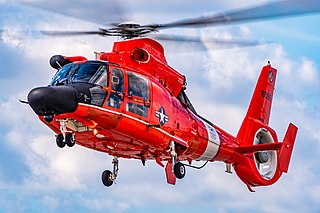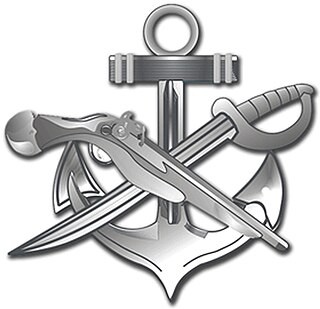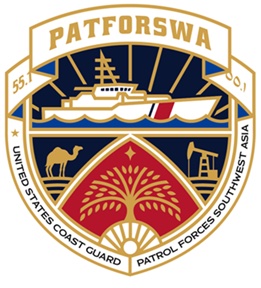The United States Armed Forces are the military forces of the United States. The armed forces consists of six service branches: the Army, Marine Corps, Navy, Air Force, Space Force, and Coast Guard. All six armed services are among the eight uniformed services of the United States.

The United States Coast Guard (USCG) is the maritime security, search and rescue, and law enforcement service branch of the United States Armed Forces and one of the country's eight uniformed services. The service is a maritime, military, multi-mission service unique among the United States military branches for having a maritime law enforcement mission with jurisdiction in both domestic and international waters and a federal regulatory agency mission as part of its duties. It is the largest coast guard in the world, rivaling the capabilities and size of most navies.

The Eurocopter MH-65 Dolphin is a twin-engined helicopter operated by the United States Coast Guard (USCG) for medevac-capable search and rescue (SAR) and armed Airborne Use of Force missions. It is a variant of the French-built Eurocopter AS365 Dauphin.

The United States Coast Guard Auxiliary is the uniformed, non-military volunteer component of the United States Coast Guard. Congress established the unit on 23 June 1939, as the United States Coast Guard Reserve. On February 19, 1941, the entity was renamed the United States Coast Guard Auxiliary. The Auxiliary's purpose is to bolster all USCG undertakings both at sea and in the sky, with the exception of tasks necessitating "direct" law enforcement or military actions. As of 2022, the U.S. Coast Guard Auxiliary boasted around 21,000 members.

The United States Coast Guard Reserve is the reserve component of the United States Coast Guard. It is organized, trained, administered, and supplied under the direction of the Commandant of the Coast Guard through the Assistant Commandant for Reserve (CG-R).

A Maritime Safety and Security Team, or MSST, is a counter-terrorism team of the United States Coast Guard established to protect local maritime assets. It is also a harbor and inshore patrol and security team that includes detecting and, if necessary, stopping or arresting submerged divers, using the Underwater Port Security System. It is the only special force that can arrest submerged divers.

U.S. Coast Guard Port Security Units are Deployable Specialized Forces organized for sustained force protection operations. They provide Anti-Terrorism Force Protection (ATFP) missions, which include harbor and port defense, protection of High Value Assets (HVAs), Sea Lines of Communications (SLOCs), special missions. and coastal surveillance. PSUs are expeditionary units that conduct OCONUS missions in support of a requesting regional combatant commander. PSUs usually operate under the direction of the Coast Guard's Pacific Area (PACAREA) command but are unique in that they are the only Coast Guard units that can be quickly requested by the Department of Defense.

Law Enforcement Detachments or LEDETs are specialized, deployable maritime law enforcement teams of the United States Coast Guard. First established in 1982, their primary mission is to deploy aboard U.S. and allied naval vessels to conduct and support maritime law enforcement, interdiction, or security operations. LEDETs are the operational elements of the Coast Guard’s two Tactical Law Enforcement Teams (TACLETs) which are part of the Coast Guard’s Deployable Specialized Forces (DSF). As of April 2010 there are seventeen LEDETs.
The United States Coast Guard is the coastal defense, search and rescue, and maritime law enforcement branch of the United States Armed Forces and is one of the country's eight uniformed services. It carries out three basic roles, which are further subdivided into eleven statutory missions. The three roles are:
This article covers the organization of the United States Coast Guard.

Visit, board, search, and seizure (VBSS) is the term used by United States military and law enforcement agencies for maritime boarding actions and tactics. VBSS teams are designed to capture enemy vessels, combat terrorism, piracy, and smuggling, and to conduct customs, safety and other inspections.

The Navy Expeditionary Combat Command (NECC) is an echelon III command of the United States Navy, which serves as the single functional command to centrally manage current and future readiness, resources, manning, training and equipping of the United States Navy's 21,000 expeditionary forces who are currently serving in every theater of operation. The NECC was established in January 2006. NECC is a subordinate command of the Navy's Fleet Forces Command.
A Sector is a shore-based operational unit of the United States Coast Guard. Each Sector is responsible for the execution of all Coast Guard missions within its Area of Responsibility (AOR), with operational support from Coast Guard Cutters and Air Stations. Subordinate commands within a Sector typically include Stations and Aids-to-Navigation (ATON) Teams. Some Sector commands also have subordinate units such as Sector Field Offices and Marine Safety Units that are responsible for mission execution in parts of the Sector's AOR. There are 37 sectors within the Coast Guard.

The US employs divers in several branches of the armed forces, including the navy, army, marines, air force and coast guard.

The Special Warfare Combat Crewmen (SWCC ) are United States Naval Special Warfare Command personnel who operate and maintain small craft for special operations missions, particularly those of U.S. Navy SEALs. Their rating is Special Warfare Boat Operator (SB).

The Deployable Specialized Forces (DSF) —formerly Deployable Operations Group— part of the United States Coast Guard that provide highly equipped, trained and organized deployable specialized forces, to the Coast Guard, United States Department of Homeland Security (DHS), United States Department of Defense (DoD) and inter-agency operational and tactical commanders. The command was formerly headquartered in Arlington, Virginia, it was established on 20 July 2007, and was commanded by a captain, the command was decommissioned by the Commandant of the Coast Guard, Admiral Robert Papp on 1 October 2013, although many of the units existed long before the 2007 commissioning. Upon decommissioning the command, the units previously assigned to the DOG were split between Coast Guard Pacific and Atlantic Area commands. The units were soon reorganized under Deployable specialized forces (DSF).

The Helicopter Interdiction Tactical Squadron (HITRON) is an armed United States Coast Guard helicopter squadron specializing in Airborne Use of Force (AUF) and drug-interdiction missions. It is based at Cecil Field in Jacksonville, Florida.

Patrol Forces Southwest Asia (PATFORSWA) is a United States Coast Guard command based in Manama, Bahrain. PATFORSWA was created in November 2002 as a contingency operation to support the U.S. Navy with patrol boats. The command's mission is to train, equip, deploy and support combat-ready Coast Guard forces conducting operations in support of Operation Iraqi Freedom (OIF), Operation Enduring Freedom (OEF) and Operation Inherent Resolve (OIR) in the Naval Forces Central Command's area of responsibility. It was commissioned as a permanent duty station in June 2004. In July 2003 PATFORSWA moved from its own compound to facilities at Naval Support Activity Bahrain.
The Maritime Enforcement Specialist (ME) rating is the uniformed law enforcement specialist of the United States Coast Guard. Responsible for law enforcement and force protection, these personnel are trained in traditional maritime law enforcement, anti-terrorism, force protection, port security and safety, and unit-level training.

The 32-foot Transportable Port Security Boat (TPSB) or , normally operated by United States Coast Guard Port Security Units (PSUs), provides for defense readiness operations in the United States and when PSUs are deployed overseas. It travels at 43-plus knots, and carries up to two .50 caliber M2 Machine Guns and two 7.62mm M240G Machine Guns. There are 52 in operation.























